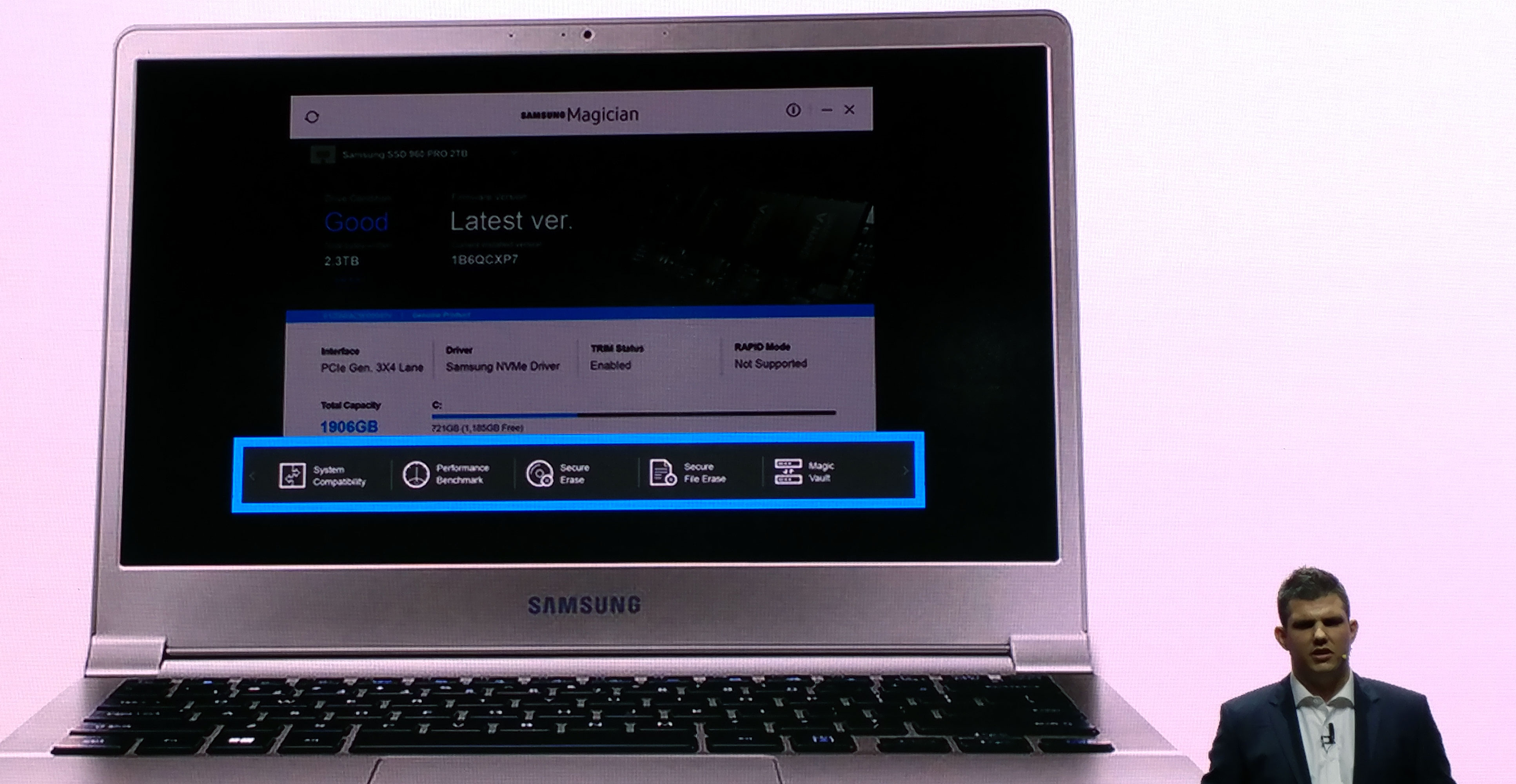
During its SSD Summit in Seoul, Samsung will announce two new SSD drives named 960 Pro and 960 EVO. Both are built on the M.2 form-factor, and NVM Express (NVMe) PCIe Gen.3 x4 interface for flash memory.
Performance increase
The new 960 SSD line of products show impressive specifications. According to Samsung, the sequential transfer read speeds top 3500 MB/s (960 Pro) and 2100 MB/s (960 EVO). I found the random read and writes operation numbers even more interesting, with 440,000 IOPS (Pro) and 360,000 IOPS (EVO) respectively.


The number of Read/Writes operations per second (or IPOS) is critical because a large number of relatively small files won’t cause any major throughput blockage. It is the capacity of treating data requests as fast as possible that become a major performance factor. This is why R/W operations is a key metric.
The new 960 series of SSD brings an enormous lift in the number of IPOS that these drives can perform. When compared to last year’s 950 Pro SSD, the 960 Pro SSD can climb to up to 440,000 IPOS, thanks to the larger capacity models.
To most consumers, the random access is the SSD performance differentiation which is the easiest to perceive. In the real world, most data are accessed randomly, and things like app launches, or boot sequences are directly impacted by the random access throughput.

In the enterprise space, some applications can be optimized for sequential data. Some of those optimizations date back from when mechanical drives ruled, or maybe the very nature of the workload lands itself to this kind of read/write sequential pattern. It’s just that it is not all that common for regular users.
Higher capacity
The Samsung 960 Pro SSD drive capacity can reach 2 TB (along with 512 GB and 1 TB models) and will cost $329 for the most affordable model. The Samsung 960 EVO will come in 250 GB, 500 GB and 1 TB capacities with pricing starting at $129.99.
960 EVO
- 250GB, 500GB and 1TB
- New: Samsung “Intelligent TurboWrite technology” sequential R/W accelerator
- This is a flash memory caching technique that allocates up to 42GB of storage as a cache (on the 1TB model)
- 3,200 MB/s (Read) / 1,900 MB/s (Write)
- Three-year limited warranty up to 400 TBW for 1TB capacity, whichever occurs first.
- Dynamic Thermal Guard technology to manage performance levels and prevent overheating
- M.2 form factor
- NVMe PCIe Gen.3 x4 lane interface
960 Pro
- 512GB and 1TB and 2TB
- Sequential speed: 3,500 MB/s (Read) / 2,100 MB/s (Write)
- Five-year limited warranty up to 1.2 Petabytes for 2TB capacity, whichever occurs first.
- Dynamic Thermal Guard technology to manage performance levels and prevent overheating
- 2 form factor
- NVMe PCIe Gen.3 x4 lane interface
Updated Software
Samsung Magician
At the user-level, Samsung has updated its Magician SSD drive manager app with a new interface. Design aside, the user can now pick and choose individual files to securely erase. For extra-security, there’s also a “Magic Vault”, which is not accessible by the OS, which makes it more secure from OS-hosted viruses and malware that could attempt to sniff/send your data.

Updated driver 2.0
The 2016 Samsung SSD 960 Series also come with a new NVMe driver. Software is a critical component of any high-performance system, and this is no exception. The driver is also necessary to support the Samsung Magician new features, so we highly recommend using the Samsung driver, even though the default Windows drivers will work.
Conclusion
From a consumer standpoint, the new SSDs reinforce Samsung’s already strong position in the high-end market, versus Intel and other players as well. Based on the technicals, Samsung’s latest 960 EVO offering is ahead of Intel’s 600p series in terms of theoretical random reads performance (300k vs. 128k IOPS).
This is an impressive lead on paper, which has to be further analyzed by independent testing. However, based on previous experience, the Samsung numbers have typically proved pretty reliable and a good indicator of what to expect.
The Samsung SSD endurance profile is also something that could provide another advantage to Samsung. Intel has a very interesting strategy with the 600p SSD which traded off endurance for low(er) cost and very good performance. That allows Intel to slightly undercut Samsung on pricing (~20% less for comparable capacity, using MSRP prices).
But as SSD endurance becomes a more and more important metric to buyers, Samsung might be able to take advantage of this mood shift. On the 960 EVO Samsung has a 3-Year Warranty vs. 5-Year for Intel’s 600p, but that warranty doesn’t cover the natural lock of memory cells that reach their maximum write cycles.
However, the difference in memory calls endurance is in Samsung’s favor (400TB EVO 960 vs. 72 TB Intel 600p ). That said, the endurance metric based on TBW (TeraBytes Written) depends heavily on one’s usage pattern, SSD controller and memory call management algorithms. It is a guidance, but not an absolute indicator thaat should be compared Apples to Apples.
The SSD market remains a place of intense competition, and the real winners are consumers. Every year, tech companies push the envelope to deliver more capacity at lower price. Flash storage is one of the areas where Moore’s Law still rules, making capacity explode and crushing prices.
Disclosure: Ubergizmo’s travel and accommodation to the Samsung SSD Summit have been arranged Samsung. Many international media outlets and journalists have been invited under the same initiative. Consult our Travel Policy and previous disclosures.
Filed in . Read more about Samsung, Samsung SSD, Ssd and Storage.






















